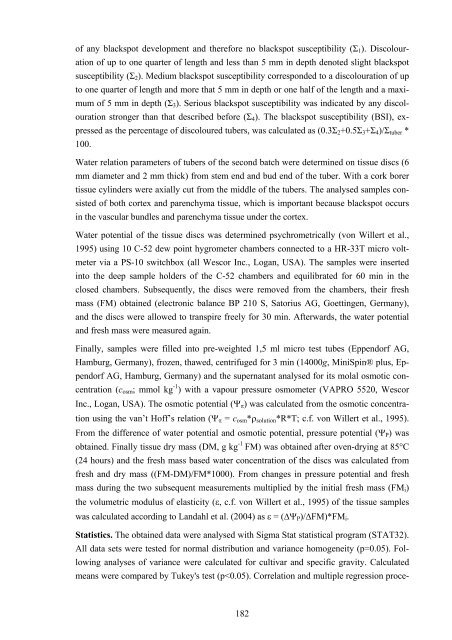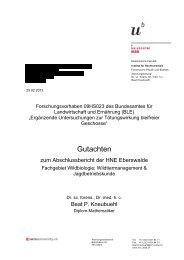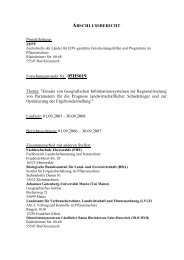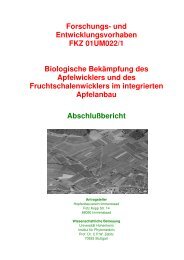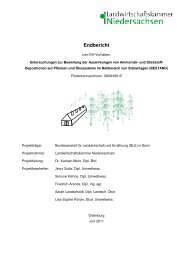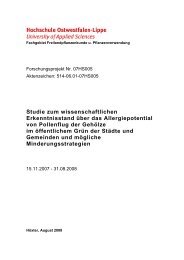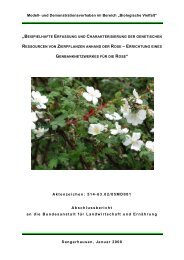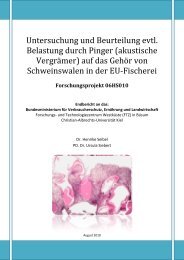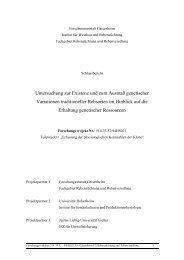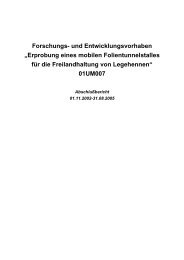Abschlussbericht Projekt: „Verminderung der ... - BLE
Abschlussbericht Projekt: „Verminderung der ... - BLE
Abschlussbericht Projekt: „Verminderung der ... - BLE
Sie wollen auch ein ePaper? Erhöhen Sie die Reichweite Ihrer Titel.
YUMPU macht aus Druck-PDFs automatisch weboptimierte ePaper, die Google liebt.
of any blackspot development and therefore no blackspot susceptibility (Σ 1 ). Discolouration<br />
of up to one quarter of length and less than 5 mm in depth denoted slight blackspot<br />
susceptibility (Σ 2 ). Medium blackspot susceptibility corresponded to a discolouration of up<br />
to one quarter of length and more that 5 mm in depth or one half of the length and a maximum<br />
of 5 mm in depth (Σ 3 ). Serious blackspot susceptibility was indicated by any discolouration<br />
stronger than that described before (Σ 4 ). The blackspot susceptibility (BSI), expressed<br />
as the percentage of discoloured tubers, was calculated as (0.3Σ 2 +0.5Σ 3 +Σ 4 )/Σ tuber *<br />
100.<br />
Water relation parameters of tubers of the second batch were determined on tissue discs (6<br />
mm diameter and 2 mm thick) from stem end and bud end of the tuber. With a cork borer<br />
tissue cylin<strong>der</strong>s were axially cut from the middle of the tubers. The analysed samples consisted<br />
of both cortex and parenchyma tissue, which is important because blackspot occurs<br />
in the vascular bundles and parenchyma tissue un<strong>der</strong> the cortex.<br />
Water potential of the tissue discs was determined psychrometrically (von Willert et al.,<br />
1995) using 10 C-52 dew point hygrometer chambers connected to a HR-33T micro voltmeter<br />
via a PS-10 switchbox (all Wescor Inc., Logan, USA). The samples were inserted<br />
into the deep sample hol<strong>der</strong>s of the C-52 chambers and equilibrated for 60 min in the<br />
closed chambers. Subsequently, the discs were removed from the chambers, their fresh<br />
mass (FM) obtained (electronic balance BP 210 S, Satorius AG, Goettingen, Germany),<br />
and the discs were allowed to transpire freely for 30 min. Afterwards, the water potential<br />
and fresh mass were measured again.<br />
Finally, samples were filled into pre-weighted 1,5 ml micro test tubes (Eppendorf AG,<br />
Hamburg, Germany), frozen, thawed, centrifuged for 3 min (14000g, MiniSpin® plus, Eppendorf<br />
AG, Hamburg, Germany) and the supernatant analysed for its molal osmotic concentration<br />
(c osm ; mmol kg -1 ) with a vapour pressure osmometer (VAPRO 5520, Wescor<br />
Inc., Logan, USA). The osmotic potential (Ψ π ) was calculated from the osmotic concentration<br />
using the van’t Hoff’s relation (Ψ π = c osm *ρ solution *R*T; c.f. von Willert et al., 1995).<br />
From the difference of water potential and osmotic potential, pressure potential (Ψ P ) was<br />
obtained. Finally tissue dry mass (DM, g kg -1 FM) was obtained after oven-drying at 85°C<br />
(24 hours) and the fresh mass based water concentration of the discs was calculated from<br />
fresh and dry mass ((FM-DM)/FM*1000). From changes in pressure potential and fresh<br />
mass during the two subsequent measurements multiplied by the initial fresh mass (FM i )<br />
the volumetric modulus of elasticity (ε, c.f. von Willert et al., 1995) of the tissue samples<br />
was calculated according to Landahl et al. (2004) as ε = (ΔΨ P )/ΔFM)*FM i .<br />
Statistics. The obtained data were analysed with Sigma Stat statistical program (STAT32).<br />
All data sets were tested for normal distribution and variance homogeneity (p=0.05). Following<br />
analyses of variance were calculated for cultivar and specific gravity. Calculated<br />
means were compared by Tukey's test (p


